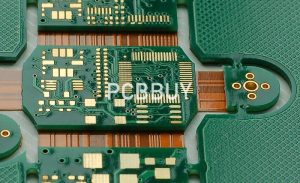Types of Industries That Use Rigid Flex PCBs
Industries That Use Rigid Flex PCBs
A rigid flex board is an electronic circuit that is capable of both flexibility and stability. It is commonly used in electronic devices that are subject to extreme movement or vibrations, including portable electronics such as smartphones and headsets, and industrial machinery like automobile components.
These hybrid PCBs offer a wide range of benefits, from enhanced connectivity and improved functionality to reduced assembly costs and lower power consumption. They also occupy less space than traditional printed circuit boards, making them ideal for products that need to be compact and lightweight. In addition, rigid flex board can be designed with a variety of materials and layouts to meet specific industry requirements.

The rigid sections of the circuit board are connected to the flexible parts by a thin, stiff section, which helps keep them from bending or flexing too much. This rigidity allows designers to incorporate mountable components into the flex sections, increasing component density and eliminating the need for extra connectors or wires. Rigid flex boards are also able to handle more mechanical stress than fully rigid or flexible circuit boards, thanks to their reinforced designs.
Types of Industries That Use Rigid Flex PCBs
Rigid flex circuit boards are often used in electronic devices that require a high level of reliability and durability, including medical equipment such as pacemakers, cochlear implants, and handheld monitors; aerospace and military applications, such as aircraft or missile-launch detectors; automotive electronics, such as dashboard or braking controls; and wearable electronics, such as mobile devices and smartwatches. They are also suitable for use in environments with harsh environmental conditions, such as high humidity or temperatures, and can withstand heavy shocks or vibrations.
When designing a rigid flex circuit board, it’s important to consider the materials that will be used and their thermal, chemical, and mechanical properties. It is also important to take into account the board’s dimensional tolerances and manufacturability. Ideally, rigid-flex designs should be developed with Design for Manufacturability (DFM) principles and close cooperation with manufacturers to ensure the quality of the final product.
The use of rigid-flex PCBs can help reduce the amount of heat that is dissipated within a device, which in turn helps to improve its performance and protect it from damage. However, heat dissipation can still occur, particularly if the flex regions are repeatedly bent or flexed, so it’s important to choose the right materials and to adhere to rigid-flex PCB fabrication guidelines.
During operation, most electronic devices will generate heat, which is dissipated through the PCB. It’s essential that a rigid-flex circuit board’s material layup is chosen with this in mind, as this will have a significant impact on cost, performance, and manufacturability. To maximize the benefits of a rigid-flex PCB, you should seek out fabricators that specialize in these technologies. They’ll be able to provide you with a comprehensive design service that includes thorough analysis of your board’s material layout, and they will be able to suggest the best options for your project. This will allow you to create a robust and reliable device that will perform well for years to come.